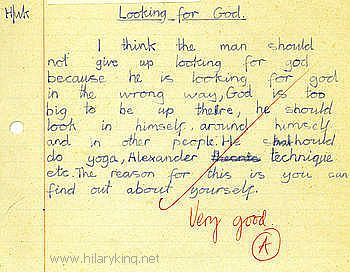In a previous Blog entry which explored the concept of end-gaining I mentioned a very stressed young woman who had come to me for her first Alexander Technique lesson, because she had high blood pressure levels, migraines and lots of tension in her neck and shoulders, which wouldn’t go away despite trying various things, including physio and yoga.
Monthly Archives: May 2012
One Child’s View of the Alexander Technique
This short piece was written by a young secondary school child for his Religious Studies homework and it illustrates an aspect of the Alexander Technique that is not often known by about many people, who often think that lessons are only about ‘sitting up straight’ – until they have experienced the work for themselves.
No mention of the Alexander Technique had been made by his school teacher. However, the boy had experienced some Alexander Technique for himself and he had also seen how people around him had changed in themselves, after taking a number of Alexander Lessons.
The boy’s words illustrate the fact that the Alexander Technique is a form of psychophysical learning which explores the relationship between the way we think and feel and the way we express those aspects of ourselves through the way we use our bodies. The Alexander Technique can even have aspects of being a spiritual experience – it’s not just a set of ordinary physical exercises that you do in order to improve your posture.
I will leave his homework to speak for itself.
